T1 2019 Holmes Institute HA3011 Advance Financial Accounting Analysis
VerifiedAdded on 2022/11/11
|12
|3046
|442
Homework Assignment
AI Summary
This assignment analyzes the financial accounting practices of Incitec Pivot, focusing on accounting concepts, the conceptual framework, and measurement issues. It examines the company's adherence to Australian Accounting Standards (AASB) and International Financial Reporting Standards (IFRS), including revenue recognition, fair value measurements, and the treatment of assets and liabilities. The assignment delves into the qualitative characteristics of financial reporting, such as verifiability, and discusses challenges in determining fair values, especially for unique assets. It covers key accounting policies related to revenue, receivables, and superannuation plans, highlighting the importance of estimates and judgments in financial statements. The document also references relevant accounting standards like AASB 15 and AASB 16 and explores the issues related to the measurement of assets and liabilities and the importance of reliability and verifiability in financial reporting. The assignment provides a comprehensive overview of the company's financial reporting practices and their compliance with accounting standards.
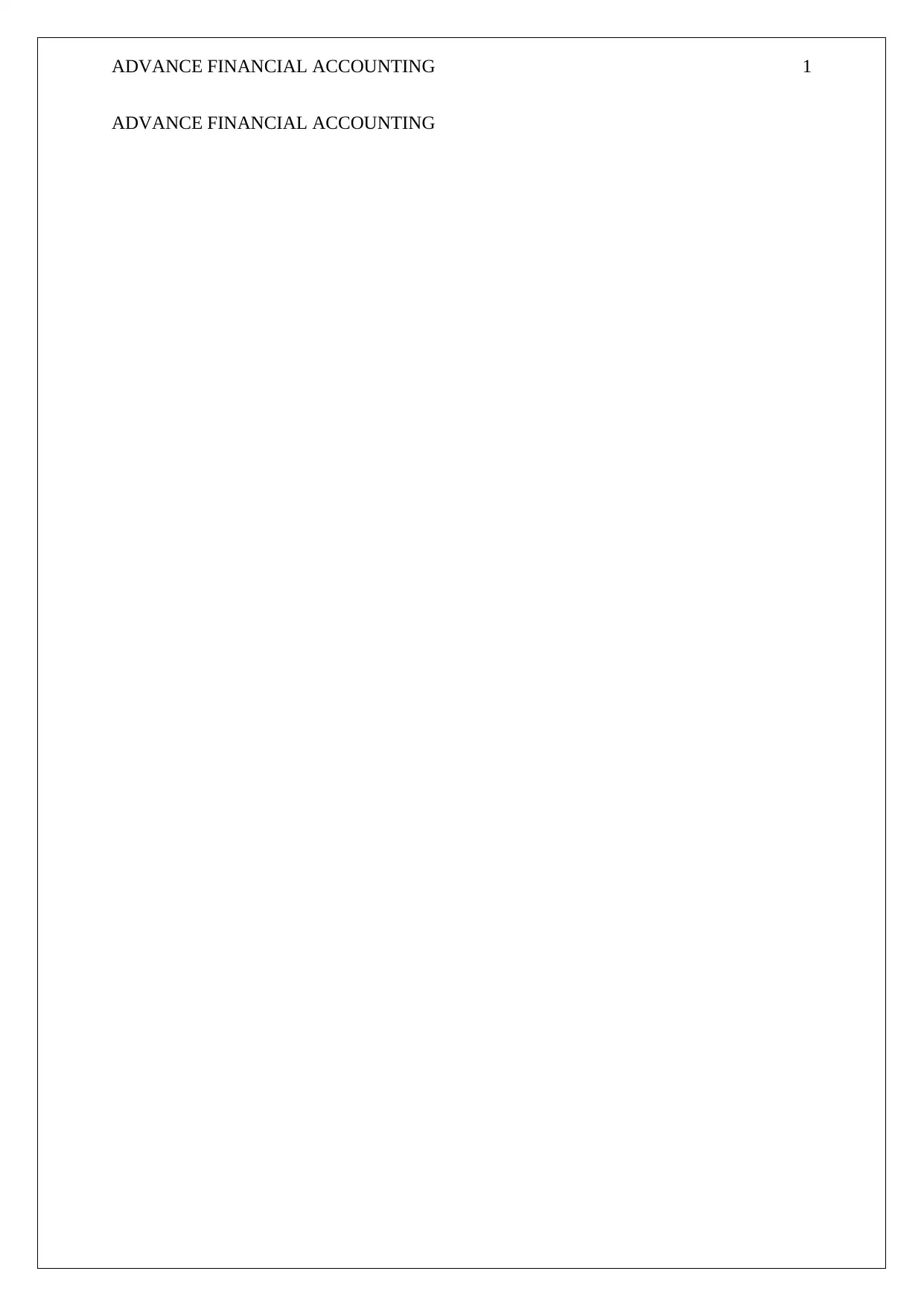
ADVANCE FINANCIAL ACCOUNTING 1
ADVANCE FINANCIAL ACCOUNTING
ADVANCE FINANCIAL ACCOUNTING
Paraphrase This Document
Need a fresh take? Get an instant paraphrase of this document with our AI Paraphraser
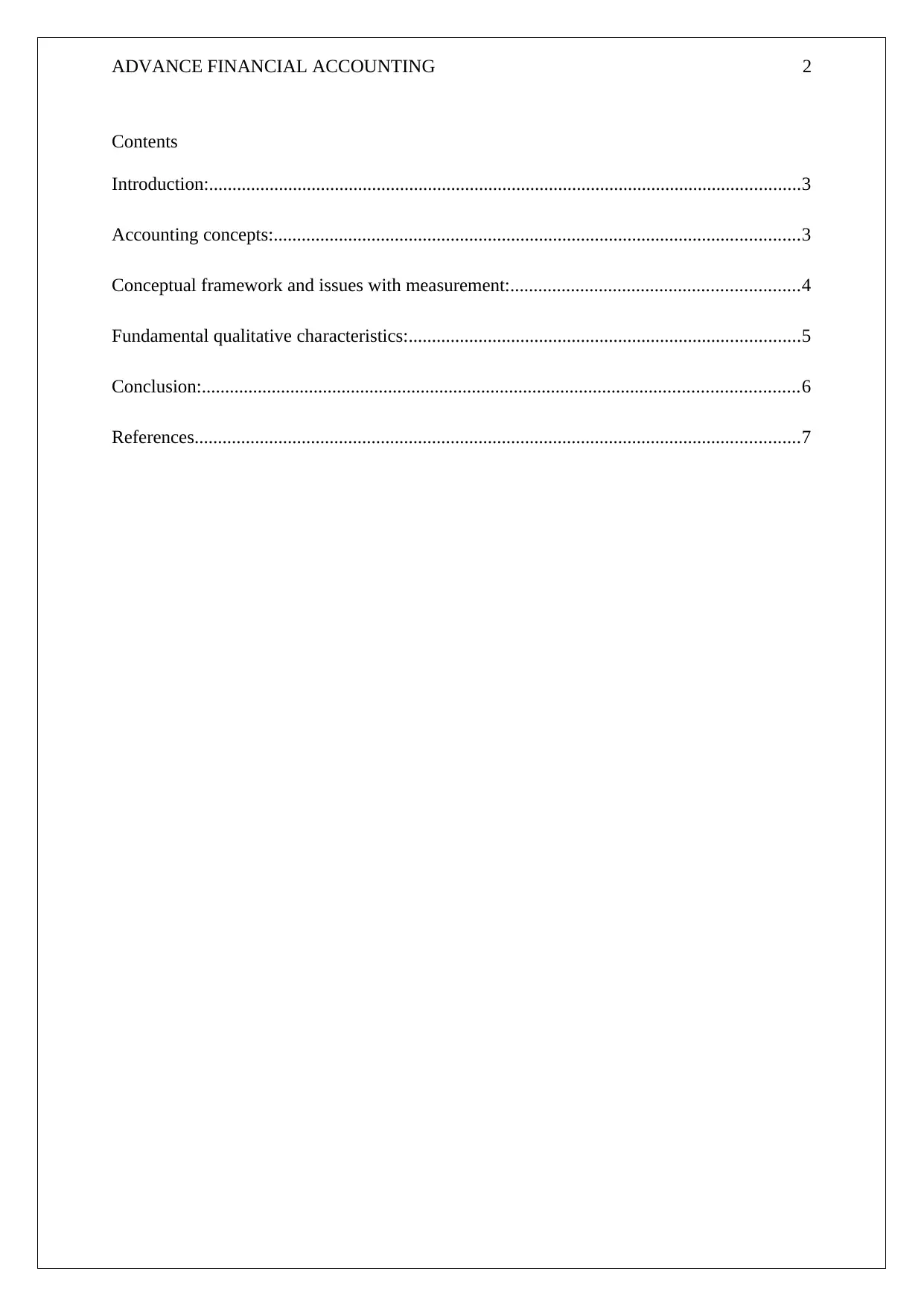
ADVANCE FINANCIAL ACCOUNTING 2
Contents
Introduction:...............................................................................................................................3
Accounting concepts:.................................................................................................................3
Conceptual framework and issues with measurement:..............................................................4
Fundamental qualitative characteristics:....................................................................................5
Conclusion:................................................................................................................................6
References..................................................................................................................................7
Contents
Introduction:...............................................................................................................................3
Accounting concepts:.................................................................................................................3
Conceptual framework and issues with measurement:..............................................................4
Fundamental qualitative characteristics:....................................................................................5
Conclusion:................................................................................................................................6
References..................................................................................................................................7
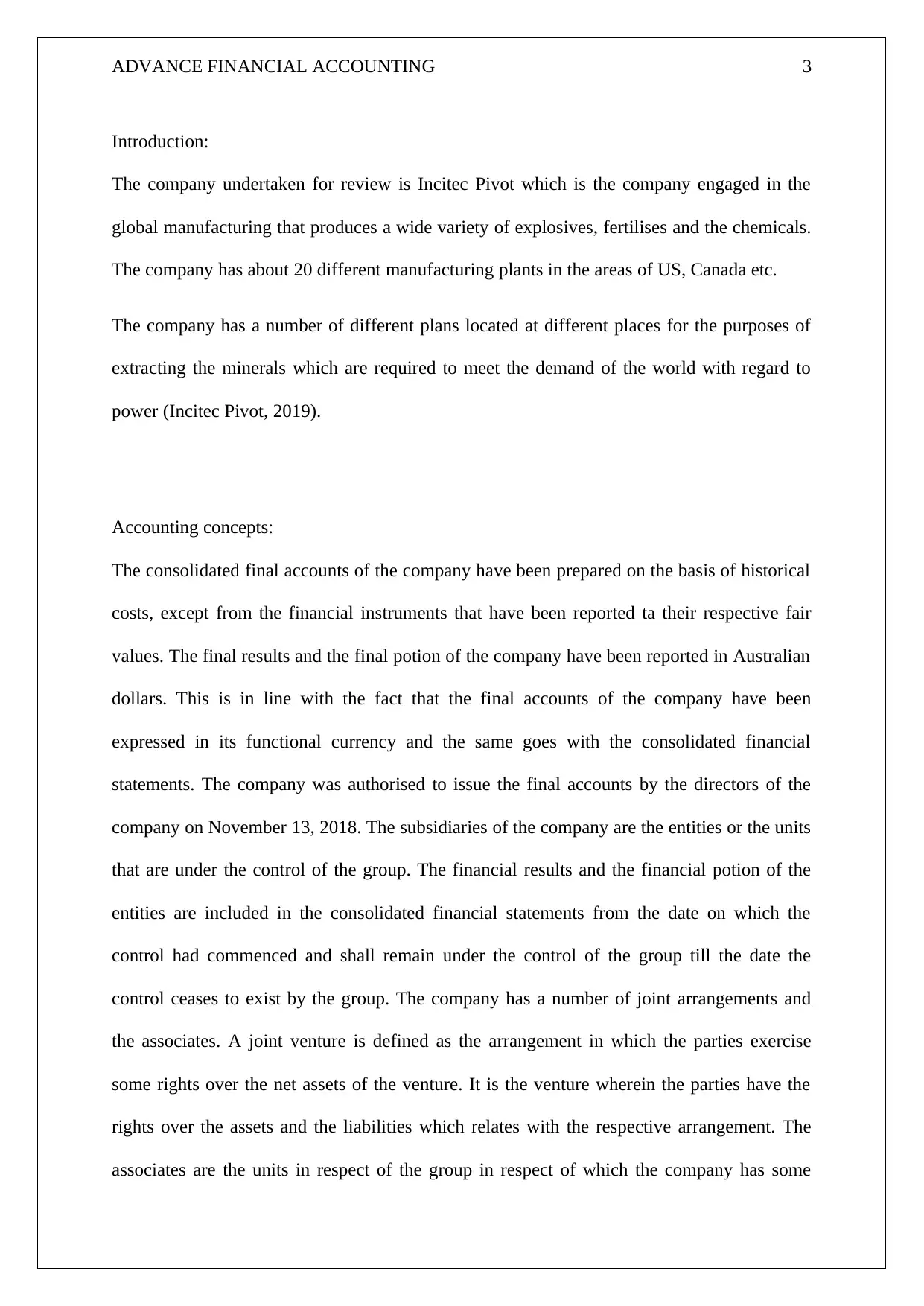
ADVANCE FINANCIAL ACCOUNTING 3
Introduction:
The company undertaken for review is Incitec Pivot which is the company engaged in the
global manufacturing that produces a wide variety of explosives, fertilises and the chemicals.
The company has about 20 different manufacturing plants in the areas of US, Canada etc.
The company has a number of different plans located at different places for the purposes of
extracting the minerals which are required to meet the demand of the world with regard to
power (Incitec Pivot, 2019).
Accounting concepts:
The consolidated final accounts of the company have been prepared on the basis of historical
costs, except from the financial instruments that have been reported ta their respective fair
values. The final results and the final potion of the company have been reported in Australian
dollars. This is in line with the fact that the final accounts of the company have been
expressed in its functional currency and the same goes with the consolidated financial
statements. The company was authorised to issue the final accounts by the directors of the
company on November 13, 2018. The subsidiaries of the company are the entities or the units
that are under the control of the group. The financial results and the financial potion of the
entities are included in the consolidated financial statements from the date on which the
control had commenced and shall remain under the control of the group till the date the
control ceases to exist by the group. The company has a number of joint arrangements and
the associates. A joint venture is defined as the arrangement in which the parties exercise
some rights over the net assets of the venture. It is the venture wherein the parties have the
rights over the assets and the liabilities which relates with the respective arrangement. The
associates are the units in respect of the group in respect of which the company has some
Introduction:
The company undertaken for review is Incitec Pivot which is the company engaged in the
global manufacturing that produces a wide variety of explosives, fertilises and the chemicals.
The company has about 20 different manufacturing plants in the areas of US, Canada etc.
The company has a number of different plans located at different places for the purposes of
extracting the minerals which are required to meet the demand of the world with regard to
power (Incitec Pivot, 2019).
Accounting concepts:
The consolidated final accounts of the company have been prepared on the basis of historical
costs, except from the financial instruments that have been reported ta their respective fair
values. The final results and the final potion of the company have been reported in Australian
dollars. This is in line with the fact that the final accounts of the company have been
expressed in its functional currency and the same goes with the consolidated financial
statements. The company was authorised to issue the final accounts by the directors of the
company on November 13, 2018. The subsidiaries of the company are the entities or the units
that are under the control of the group. The financial results and the financial potion of the
entities are included in the consolidated financial statements from the date on which the
control had commenced and shall remain under the control of the group till the date the
control ceases to exist by the group. The company has a number of joint arrangements and
the associates. A joint venture is defined as the arrangement in which the parties exercise
some rights over the net assets of the venture. It is the venture wherein the parties have the
rights over the assets and the liabilities which relates with the respective arrangement. The
associates are the units in respect of the group in respect of which the company has some
⊘ This is a preview!⊘
Do you want full access?
Subscribe today to unlock all pages.

Trusted by 1+ million students worldwide
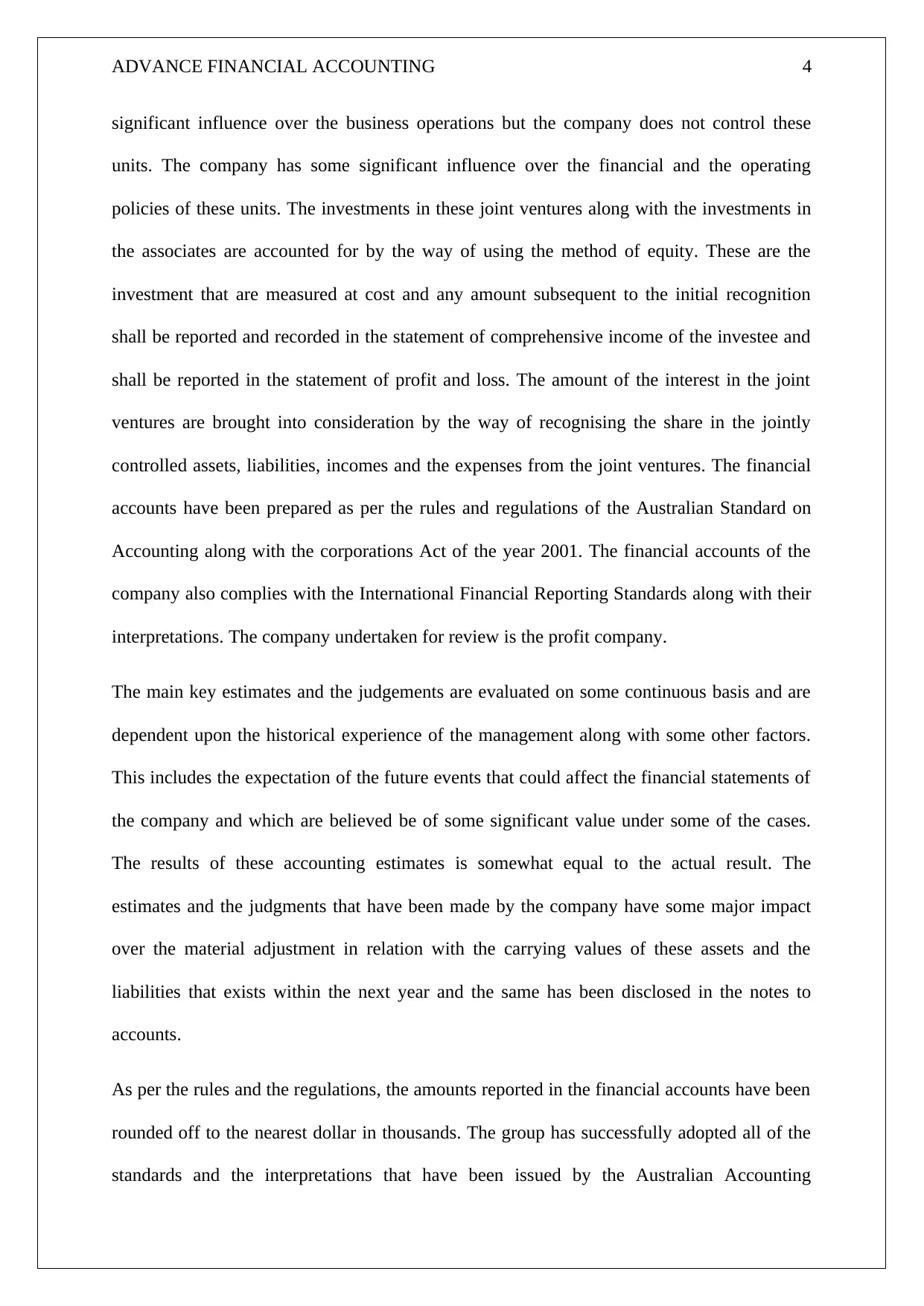
ADVANCE FINANCIAL ACCOUNTING 4
significant influence over the business operations but the company does not control these
units. The company has some significant influence over the financial and the operating
policies of these units. The investments in these joint ventures along with the investments in
the associates are accounted for by the way of using the method of equity. These are the
investment that are measured at cost and any amount subsequent to the initial recognition
shall be reported and recorded in the statement of comprehensive income of the investee and
shall be reported in the statement of profit and loss. The amount of the interest in the joint
ventures are brought into consideration by the way of recognising the share in the jointly
controlled assets, liabilities, incomes and the expenses from the joint ventures. The financial
accounts have been prepared as per the rules and regulations of the Australian Standard on
Accounting along with the corporations Act of the year 2001. The financial accounts of the
company also complies with the International Financial Reporting Standards along with their
interpretations. The company undertaken for review is the profit company.
The main key estimates and the judgements are evaluated on some continuous basis and are
dependent upon the historical experience of the management along with some other factors.
This includes the expectation of the future events that could affect the financial statements of
the company and which are believed be of some significant value under some of the cases.
The results of these accounting estimates is somewhat equal to the actual result. The
estimates and the judgments that have been made by the company have some major impact
over the material adjustment in relation with the carrying values of these assets and the
liabilities that exists within the next year and the same has been disclosed in the notes to
accounts.
As per the rules and the regulations, the amounts reported in the financial accounts have been
rounded off to the nearest dollar in thousands. The group has successfully adopted all of the
standards and the interpretations that have been issued by the Australian Accounting
significant influence over the business operations but the company does not control these
units. The company has some significant influence over the financial and the operating
policies of these units. The investments in these joint ventures along with the investments in
the associates are accounted for by the way of using the method of equity. These are the
investment that are measured at cost and any amount subsequent to the initial recognition
shall be reported and recorded in the statement of comprehensive income of the investee and
shall be reported in the statement of profit and loss. The amount of the interest in the joint
ventures are brought into consideration by the way of recognising the share in the jointly
controlled assets, liabilities, incomes and the expenses from the joint ventures. The financial
accounts have been prepared as per the rules and regulations of the Australian Standard on
Accounting along with the corporations Act of the year 2001. The financial accounts of the
company also complies with the International Financial Reporting Standards along with their
interpretations. The company undertaken for review is the profit company.
The main key estimates and the judgements are evaluated on some continuous basis and are
dependent upon the historical experience of the management along with some other factors.
This includes the expectation of the future events that could affect the financial statements of
the company and which are believed be of some significant value under some of the cases.
The results of these accounting estimates is somewhat equal to the actual result. The
estimates and the judgments that have been made by the company have some major impact
over the material adjustment in relation with the carrying values of these assets and the
liabilities that exists within the next year and the same has been disclosed in the notes to
accounts.
As per the rules and the regulations, the amounts reported in the financial accounts have been
rounded off to the nearest dollar in thousands. The group has successfully adopted all of the
standards and the interpretations that have been issued by the Australian Accounting
Paraphrase This Document
Need a fresh take? Get an instant paraphrase of this document with our AI Paraphraser
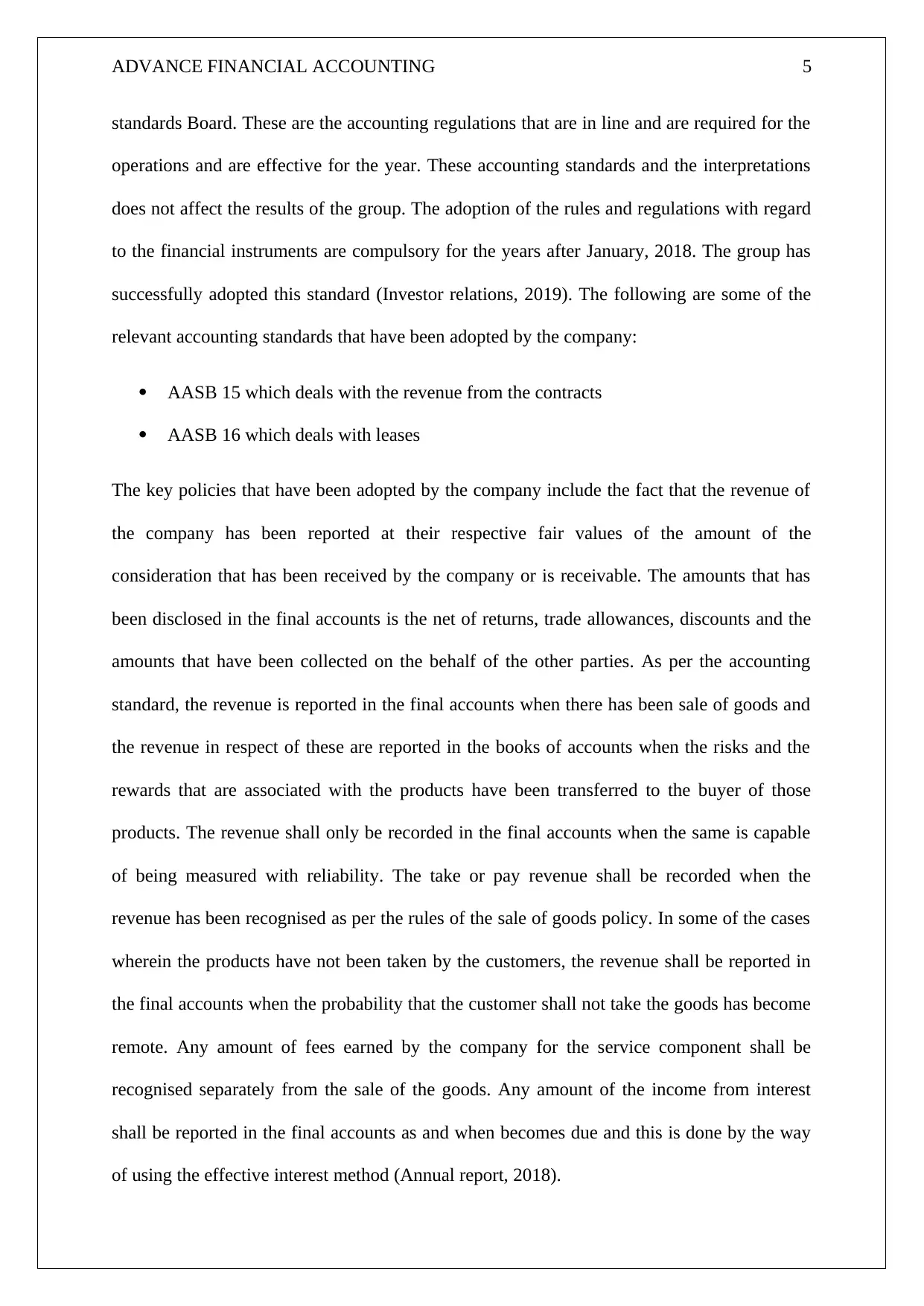
ADVANCE FINANCIAL ACCOUNTING 5
standards Board. These are the accounting regulations that are in line and are required for the
operations and are effective for the year. These accounting standards and the interpretations
does not affect the results of the group. The adoption of the rules and regulations with regard
to the financial instruments are compulsory for the years after January, 2018. The group has
successfully adopted this standard (Investor relations, 2019). The following are some of the
relevant accounting standards that have been adopted by the company:
AASB 15 which deals with the revenue from the contracts
AASB 16 which deals with leases
The key policies that have been adopted by the company include the fact that the revenue of
the company has been reported at their respective fair values of the amount of the
consideration that has been received by the company or is receivable. The amounts that has
been disclosed in the final accounts is the net of returns, trade allowances, discounts and the
amounts that have been collected on the behalf of the other parties. As per the accounting
standard, the revenue is reported in the final accounts when there has been sale of goods and
the revenue in respect of these are reported in the books of accounts when the risks and the
rewards that are associated with the products have been transferred to the buyer of those
products. The revenue shall only be recorded in the final accounts when the same is capable
of being measured with reliability. The take or pay revenue shall be recorded when the
revenue has been recognised as per the rules of the sale of goods policy. In some of the cases
wherein the products have not been taken by the customers, the revenue shall be reported in
the final accounts when the probability that the customer shall not take the goods has become
remote. Any amount of fees earned by the company for the service component shall be
recognised separately from the sale of the goods. Any amount of the income from interest
shall be reported in the final accounts as and when becomes due and this is done by the way
of using the effective interest method (Annual report, 2018).
standards Board. These are the accounting regulations that are in line and are required for the
operations and are effective for the year. These accounting standards and the interpretations
does not affect the results of the group. The adoption of the rules and regulations with regard
to the financial instruments are compulsory for the years after January, 2018. The group has
successfully adopted this standard (Investor relations, 2019). The following are some of the
relevant accounting standards that have been adopted by the company:
AASB 15 which deals with the revenue from the contracts
AASB 16 which deals with leases
The key policies that have been adopted by the company include the fact that the revenue of
the company has been reported at their respective fair values of the amount of the
consideration that has been received by the company or is receivable. The amounts that has
been disclosed in the final accounts is the net of returns, trade allowances, discounts and the
amounts that have been collected on the behalf of the other parties. As per the accounting
standard, the revenue is reported in the final accounts when there has been sale of goods and
the revenue in respect of these are reported in the books of accounts when the risks and the
rewards that are associated with the products have been transferred to the buyer of those
products. The revenue shall only be recorded in the final accounts when the same is capable
of being measured with reliability. The take or pay revenue shall be recorded when the
revenue has been recognised as per the rules of the sale of goods policy. In some of the cases
wherein the products have not been taken by the customers, the revenue shall be reported in
the final accounts when the probability that the customer shall not take the goods has become
remote. Any amount of fees earned by the company for the service component shall be
recognised separately from the sale of the goods. Any amount of the income from interest
shall be reported in the final accounts as and when becomes due and this is done by the way
of using the effective interest method (Annual report, 2018).
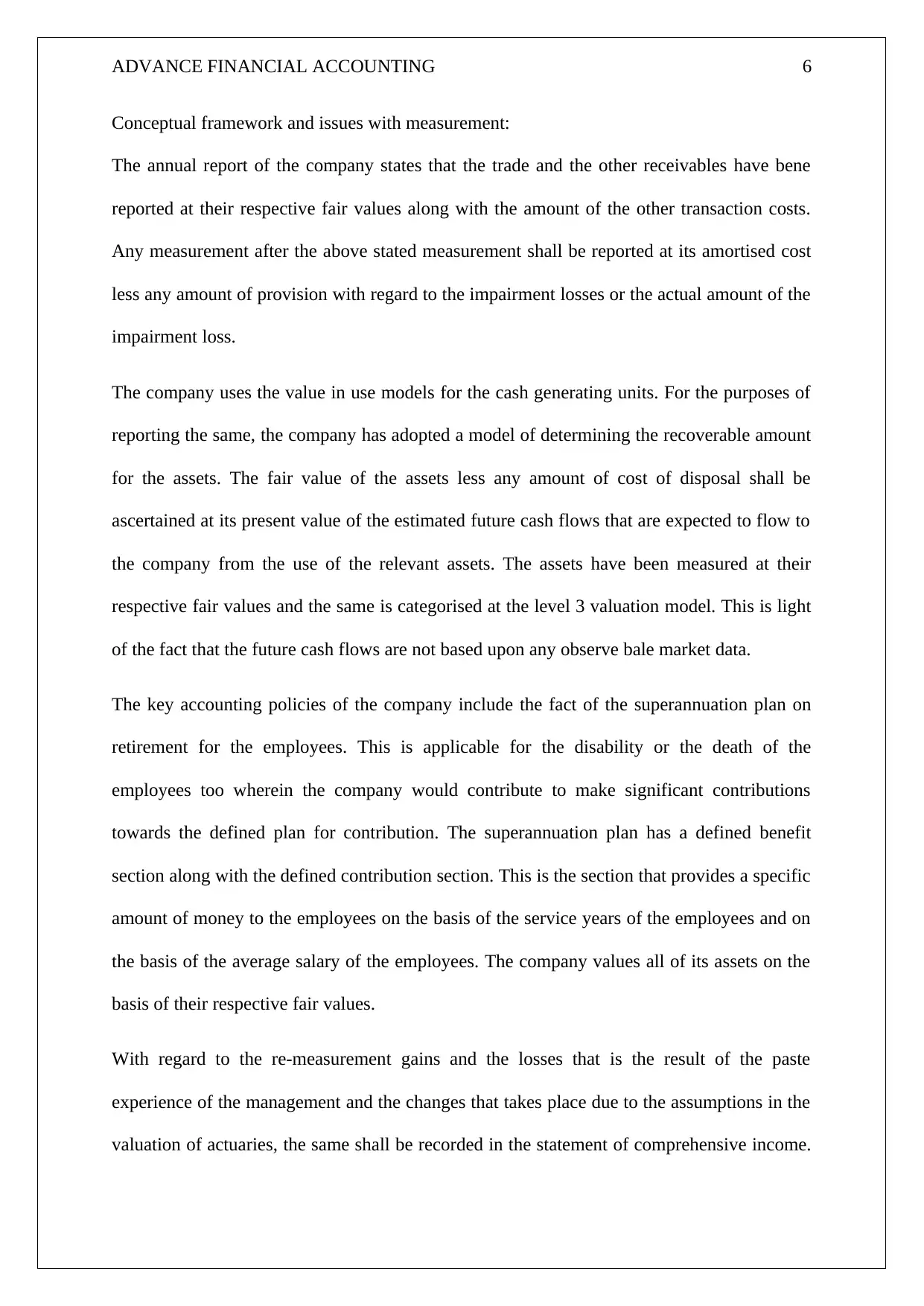
ADVANCE FINANCIAL ACCOUNTING 6
Conceptual framework and issues with measurement:
The annual report of the company states that the trade and the other receivables have bene
reported at their respective fair values along with the amount of the other transaction costs.
Any measurement after the above stated measurement shall be reported at its amortised cost
less any amount of provision with regard to the impairment losses or the actual amount of the
impairment loss.
The company uses the value in use models for the cash generating units. For the purposes of
reporting the same, the company has adopted a model of determining the recoverable amount
for the assets. The fair value of the assets less any amount of cost of disposal shall be
ascertained at its present value of the estimated future cash flows that are expected to flow to
the company from the use of the relevant assets. The assets have been measured at their
respective fair values and the same is categorised at the level 3 valuation model. This is light
of the fact that the future cash flows are not based upon any observe bale market data.
The key accounting policies of the company include the fact of the superannuation plan on
retirement for the employees. This is applicable for the disability or the death of the
employees too wherein the company would contribute to make significant contributions
towards the defined plan for contribution. The superannuation plan has a defined benefit
section along with the defined contribution section. This is the section that provides a specific
amount of money to the employees on the basis of the service years of the employees and on
the basis of the average salary of the employees. The company values all of its assets on the
basis of their respective fair values.
With regard to the re-measurement gains and the losses that is the result of the paste
experience of the management and the changes that takes place due to the assumptions in the
valuation of actuaries, the same shall be recorded in the statement of comprehensive income.
Conceptual framework and issues with measurement:
The annual report of the company states that the trade and the other receivables have bene
reported at their respective fair values along with the amount of the other transaction costs.
Any measurement after the above stated measurement shall be reported at its amortised cost
less any amount of provision with regard to the impairment losses or the actual amount of the
impairment loss.
The company uses the value in use models for the cash generating units. For the purposes of
reporting the same, the company has adopted a model of determining the recoverable amount
for the assets. The fair value of the assets less any amount of cost of disposal shall be
ascertained at its present value of the estimated future cash flows that are expected to flow to
the company from the use of the relevant assets. The assets have been measured at their
respective fair values and the same is categorised at the level 3 valuation model. This is light
of the fact that the future cash flows are not based upon any observe bale market data.
The key accounting policies of the company include the fact of the superannuation plan on
retirement for the employees. This is applicable for the disability or the death of the
employees too wherein the company would contribute to make significant contributions
towards the defined plan for contribution. The superannuation plan has a defined benefit
section along with the defined contribution section. This is the section that provides a specific
amount of money to the employees on the basis of the service years of the employees and on
the basis of the average salary of the employees. The company values all of its assets on the
basis of their respective fair values.
With regard to the re-measurement gains and the losses that is the result of the paste
experience of the management and the changes that takes place due to the assumptions in the
valuation of actuaries, the same shall be recorded in the statement of comprehensive income.
⊘ This is a preview!⊘
Do you want full access?
Subscribe today to unlock all pages.

Trusted by 1+ million students worldwide
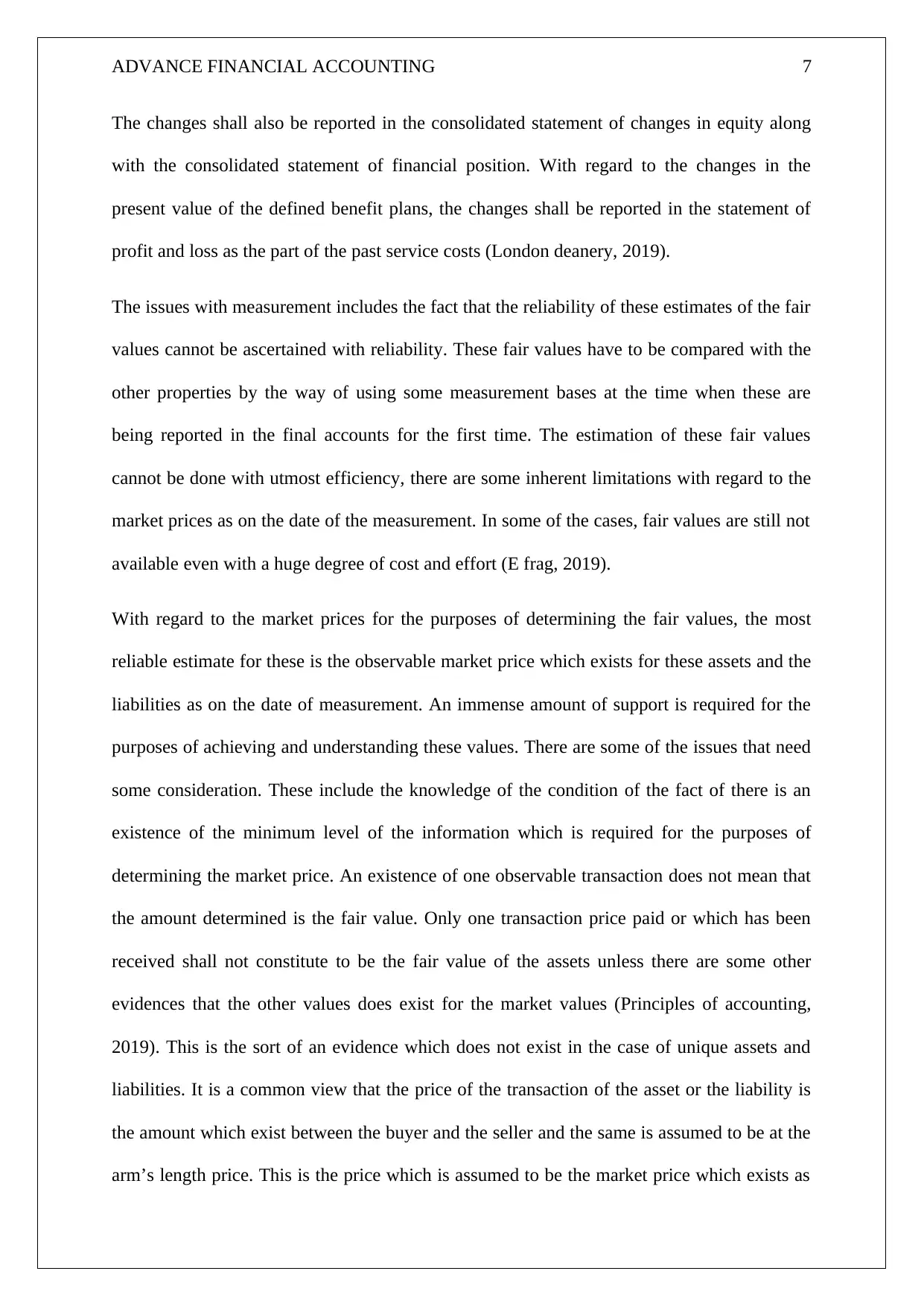
ADVANCE FINANCIAL ACCOUNTING 7
The changes shall also be reported in the consolidated statement of changes in equity along
with the consolidated statement of financial position. With regard to the changes in the
present value of the defined benefit plans, the changes shall be reported in the statement of
profit and loss as the part of the past service costs (London deanery, 2019).
The issues with measurement includes the fact that the reliability of these estimates of the fair
values cannot be ascertained with reliability. These fair values have to be compared with the
other properties by the way of using some measurement bases at the time when these are
being reported in the final accounts for the first time. The estimation of these fair values
cannot be done with utmost efficiency, there are some inherent limitations with regard to the
market prices as on the date of the measurement. In some of the cases, fair values are still not
available even with a huge degree of cost and effort (E frag, 2019).
With regard to the market prices for the purposes of determining the fair values, the most
reliable estimate for these is the observable market price which exists for these assets and the
liabilities as on the date of measurement. An immense amount of support is required for the
purposes of achieving and understanding these values. There are some of the issues that need
some consideration. These include the knowledge of the condition of the fact of there is an
existence of the minimum level of the information which is required for the purposes of
determining the market price. An existence of one observable transaction does not mean that
the amount determined is the fair value. Only one transaction price paid or which has been
received shall not constitute to be the fair value of the assets unless there are some other
evidences that the other values does exist for the market values (Principles of accounting,
2019). This is the sort of an evidence which does not exist in the case of unique assets and
liabilities. It is a common view that the price of the transaction of the asset or the liability is
the amount which exist between the buyer and the seller and the same is assumed to be at the
arm’s length price. This is the price which is assumed to be the market price which exists as
The changes shall also be reported in the consolidated statement of changes in equity along
with the consolidated statement of financial position. With regard to the changes in the
present value of the defined benefit plans, the changes shall be reported in the statement of
profit and loss as the part of the past service costs (London deanery, 2019).
The issues with measurement includes the fact that the reliability of these estimates of the fair
values cannot be ascertained with reliability. These fair values have to be compared with the
other properties by the way of using some measurement bases at the time when these are
being reported in the final accounts for the first time. The estimation of these fair values
cannot be done with utmost efficiency, there are some inherent limitations with regard to the
market prices as on the date of the measurement. In some of the cases, fair values are still not
available even with a huge degree of cost and effort (E frag, 2019).
With regard to the market prices for the purposes of determining the fair values, the most
reliable estimate for these is the observable market price which exists for these assets and the
liabilities as on the date of measurement. An immense amount of support is required for the
purposes of achieving and understanding these values. There are some of the issues that need
some consideration. These include the knowledge of the condition of the fact of there is an
existence of the minimum level of the information which is required for the purposes of
determining the market price. An existence of one observable transaction does not mean that
the amount determined is the fair value. Only one transaction price paid or which has been
received shall not constitute to be the fair value of the assets unless there are some other
evidences that the other values does exist for the market values (Principles of accounting,
2019). This is the sort of an evidence which does not exist in the case of unique assets and
liabilities. It is a common view that the price of the transaction of the asset or the liability is
the amount which exist between the buyer and the seller and the same is assumed to be at the
arm’s length price. This is the price which is assumed to be the market price which exists as
Paraphrase This Document
Need a fresh take? Get an instant paraphrase of this document with our AI Paraphraser
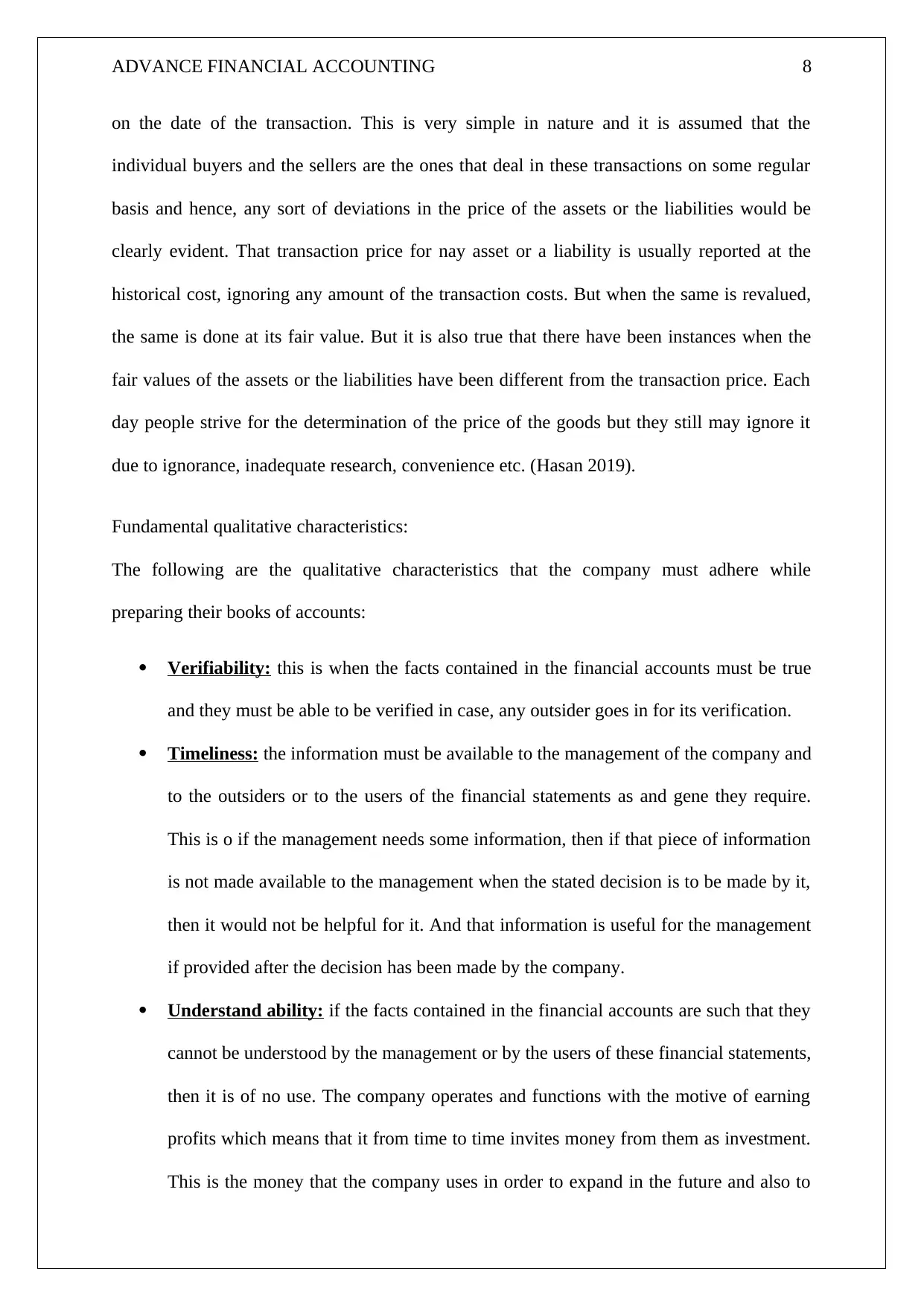
ADVANCE FINANCIAL ACCOUNTING 8
on the date of the transaction. This is very simple in nature and it is assumed that the
individual buyers and the sellers are the ones that deal in these transactions on some regular
basis and hence, any sort of deviations in the price of the assets or the liabilities would be
clearly evident. That transaction price for nay asset or a liability is usually reported at the
historical cost, ignoring any amount of the transaction costs. But when the same is revalued,
the same is done at its fair value. But it is also true that there have been instances when the
fair values of the assets or the liabilities have been different from the transaction price. Each
day people strive for the determination of the price of the goods but they still may ignore it
due to ignorance, inadequate research, convenience etc. (Hasan 2019).
Fundamental qualitative characteristics:
The following are the qualitative characteristics that the company must adhere while
preparing their books of accounts:
Verifiability: this is when the facts contained in the financial accounts must be true
and they must be able to be verified in case, any outsider goes in for its verification.
Timeliness: the information must be available to the management of the company and
to the outsiders or to the users of the financial statements as and gene they require.
This is o if the management needs some information, then if that piece of information
is not made available to the management when the stated decision is to be made by it,
then it would not be helpful for it. And that information is useful for the management
if provided after the decision has been made by the company.
Understand ability: if the facts contained in the financial accounts are such that they
cannot be understood by the management or by the users of these financial statements,
then it is of no use. The company operates and functions with the motive of earning
profits which means that it from time to time invites money from them as investment.
This is the money that the company uses in order to expand in the future and also to
on the date of the transaction. This is very simple in nature and it is assumed that the
individual buyers and the sellers are the ones that deal in these transactions on some regular
basis and hence, any sort of deviations in the price of the assets or the liabilities would be
clearly evident. That transaction price for nay asset or a liability is usually reported at the
historical cost, ignoring any amount of the transaction costs. But when the same is revalued,
the same is done at its fair value. But it is also true that there have been instances when the
fair values of the assets or the liabilities have been different from the transaction price. Each
day people strive for the determination of the price of the goods but they still may ignore it
due to ignorance, inadequate research, convenience etc. (Hasan 2019).
Fundamental qualitative characteristics:
The following are the qualitative characteristics that the company must adhere while
preparing their books of accounts:
Verifiability: this is when the facts contained in the financial accounts must be true
and they must be able to be verified in case, any outsider goes in for its verification.
Timeliness: the information must be available to the management of the company and
to the outsiders or to the users of the financial statements as and gene they require.
This is o if the management needs some information, then if that piece of information
is not made available to the management when the stated decision is to be made by it,
then it would not be helpful for it. And that information is useful for the management
if provided after the decision has been made by the company.
Understand ability: if the facts contained in the financial accounts are such that they
cannot be understood by the management or by the users of these financial statements,
then it is of no use. The company operates and functions with the motive of earning
profits which means that it from time to time invites money from them as investment.
This is the money that the company uses in order to expand in the future and also to
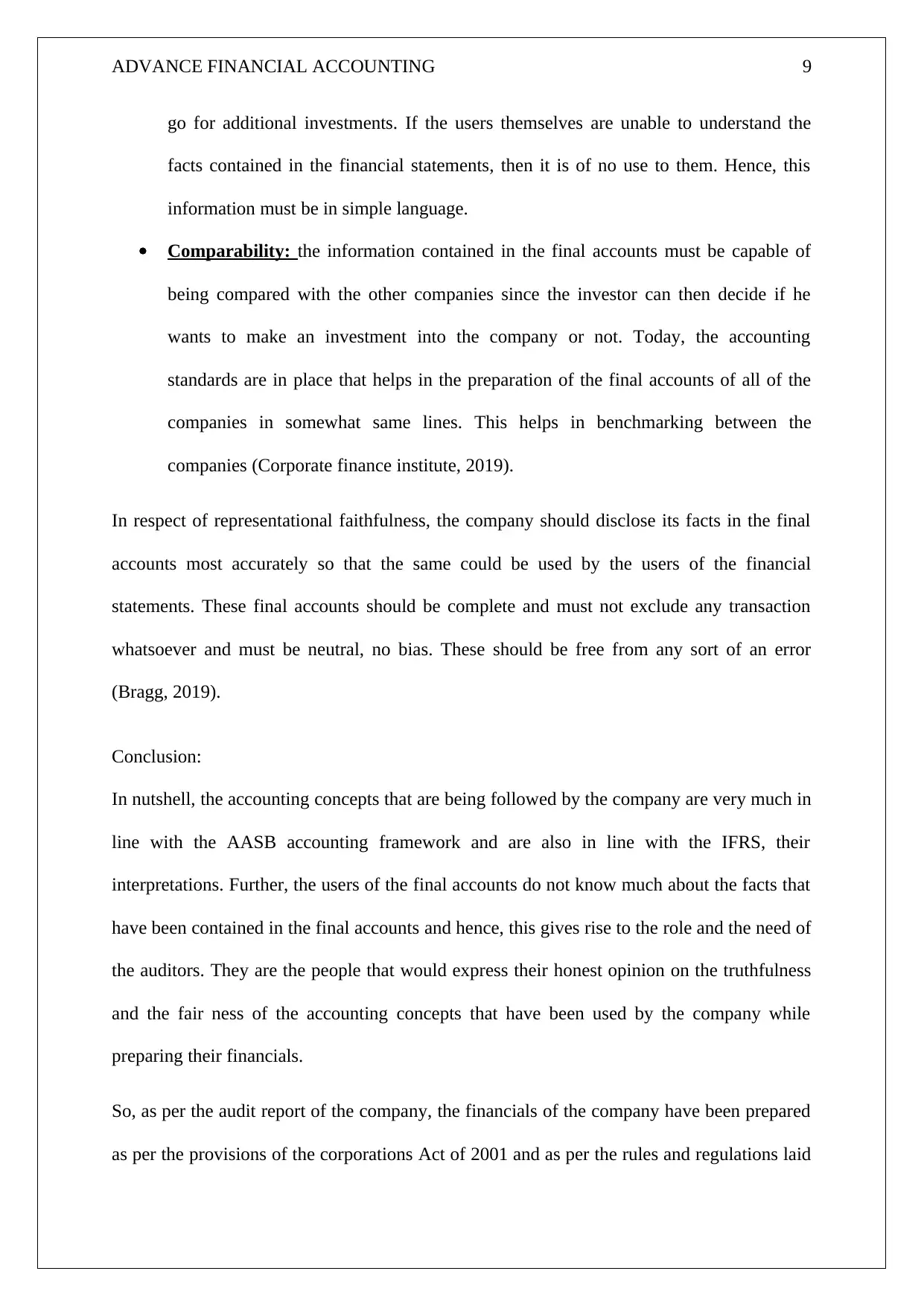
ADVANCE FINANCIAL ACCOUNTING 9
go for additional investments. If the users themselves are unable to understand the
facts contained in the financial statements, then it is of no use to them. Hence, this
information must be in simple language.
Comparability: the information contained in the final accounts must be capable of
being compared with the other companies since the investor can then decide if he
wants to make an investment into the company or not. Today, the accounting
standards are in place that helps in the preparation of the final accounts of all of the
companies in somewhat same lines. This helps in benchmarking between the
companies (Corporate finance institute, 2019).
In respect of representational faithfulness, the company should disclose its facts in the final
accounts most accurately so that the same could be used by the users of the financial
statements. These final accounts should be complete and must not exclude any transaction
whatsoever and must be neutral, no bias. These should be free from any sort of an error
(Bragg, 2019).
Conclusion:
In nutshell, the accounting concepts that are being followed by the company are very much in
line with the AASB accounting framework and are also in line with the IFRS, their
interpretations. Further, the users of the final accounts do not know much about the facts that
have been contained in the final accounts and hence, this gives rise to the role and the need of
the auditors. They are the people that would express their honest opinion on the truthfulness
and the fair ness of the accounting concepts that have been used by the company while
preparing their financials.
So, as per the audit report of the company, the financials of the company have been prepared
as per the provisions of the corporations Act of 2001 and as per the rules and regulations laid
go for additional investments. If the users themselves are unable to understand the
facts contained in the financial statements, then it is of no use to them. Hence, this
information must be in simple language.
Comparability: the information contained in the final accounts must be capable of
being compared with the other companies since the investor can then decide if he
wants to make an investment into the company or not. Today, the accounting
standards are in place that helps in the preparation of the final accounts of all of the
companies in somewhat same lines. This helps in benchmarking between the
companies (Corporate finance institute, 2019).
In respect of representational faithfulness, the company should disclose its facts in the final
accounts most accurately so that the same could be used by the users of the financial
statements. These final accounts should be complete and must not exclude any transaction
whatsoever and must be neutral, no bias. These should be free from any sort of an error
(Bragg, 2019).
Conclusion:
In nutshell, the accounting concepts that are being followed by the company are very much in
line with the AASB accounting framework and are also in line with the IFRS, their
interpretations. Further, the users of the final accounts do not know much about the facts that
have been contained in the final accounts and hence, this gives rise to the role and the need of
the auditors. They are the people that would express their honest opinion on the truthfulness
and the fair ness of the accounting concepts that have been used by the company while
preparing their financials.
So, as per the audit report of the company, the financials of the company have been prepared
as per the provisions of the corporations Act of 2001 and as per the rules and regulations laid
⊘ This is a preview!⊘
Do you want full access?
Subscribe today to unlock all pages.

Trusted by 1+ million students worldwide
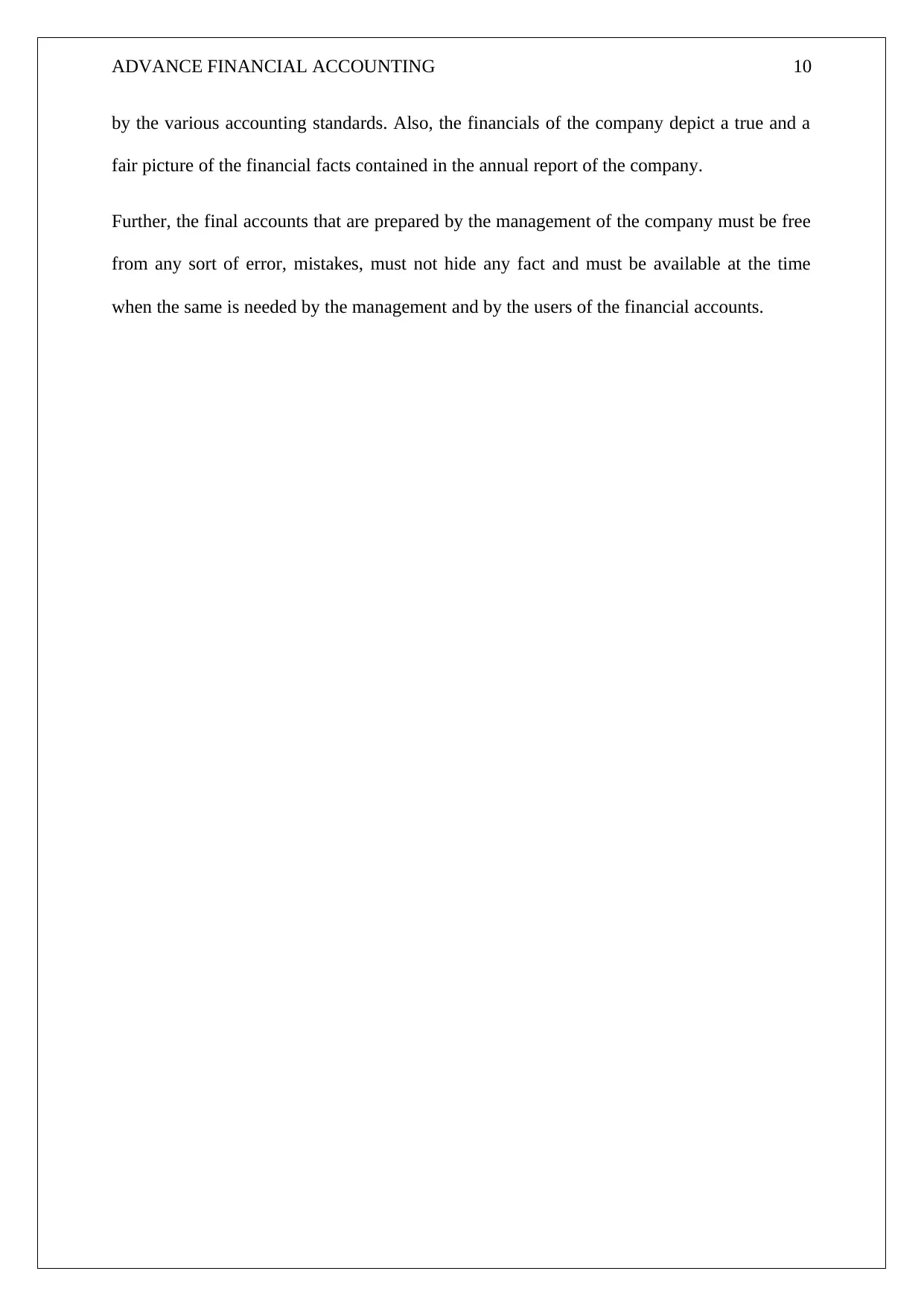
ADVANCE FINANCIAL ACCOUNTING 10
by the various accounting standards. Also, the financials of the company depict a true and a
fair picture of the financial facts contained in the annual report of the company.
Further, the final accounts that are prepared by the management of the company must be free
from any sort of error, mistakes, must not hide any fact and must be available at the time
when the same is needed by the management and by the users of the financial accounts.
by the various accounting standards. Also, the financials of the company depict a true and a
fair picture of the financial facts contained in the annual report of the company.
Further, the final accounts that are prepared by the management of the company must be free
from any sort of error, mistakes, must not hide any fact and must be available at the time
when the same is needed by the management and by the users of the financial accounts.
Paraphrase This Document
Need a fresh take? Get an instant paraphrase of this document with our AI Paraphraser
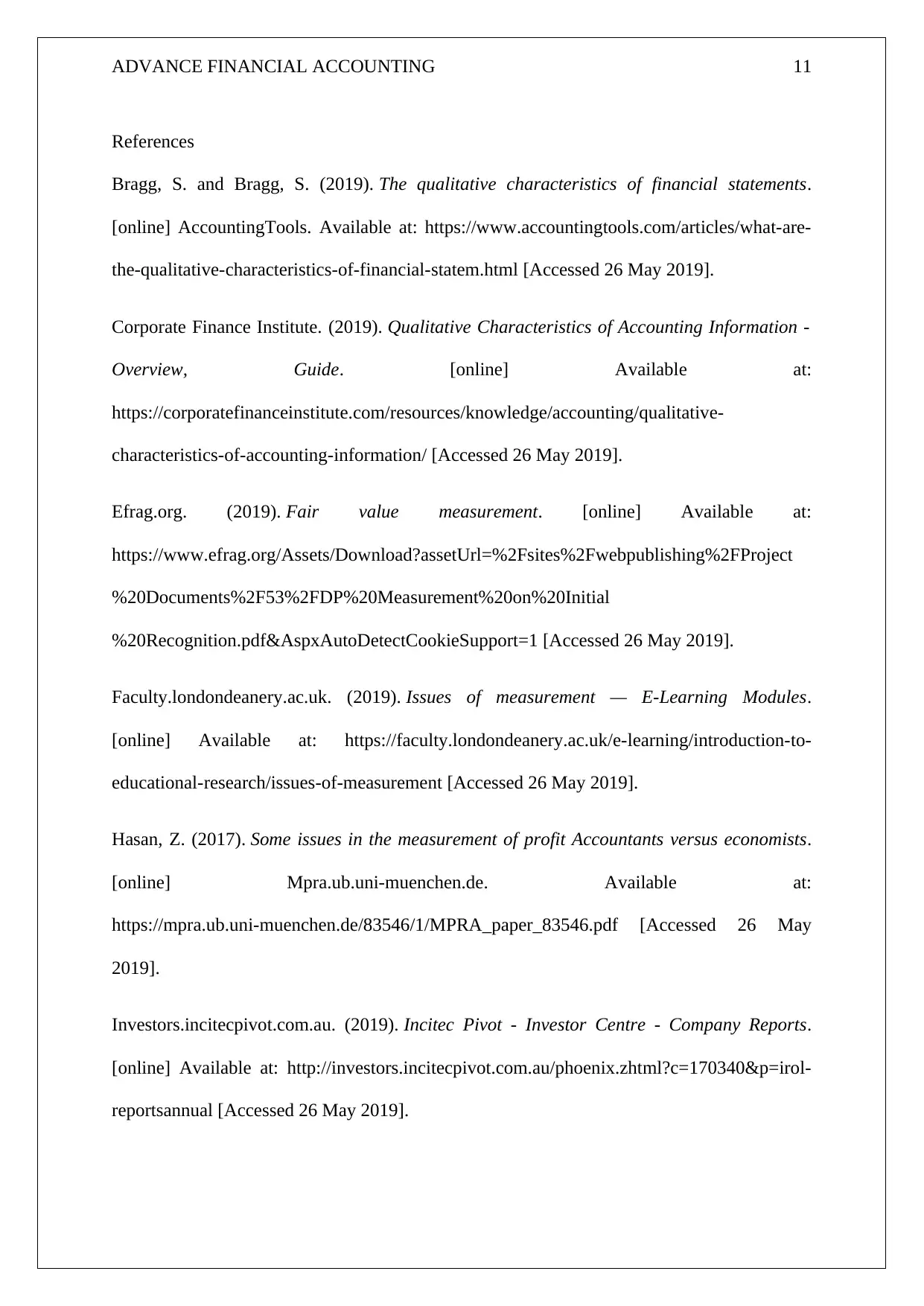
ADVANCE FINANCIAL ACCOUNTING 11
References
Bragg, S. and Bragg, S. (2019). The qualitative characteristics of financial statements.
[online] AccountingTools. Available at: https://www.accountingtools.com/articles/what-are-
the-qualitative-characteristics-of-financial-statem.html [Accessed 26 May 2019].
Corporate Finance Institute. (2019). Qualitative Characteristics of Accounting Information -
Overview, Guide. [online] Available at:
https://corporatefinanceinstitute.com/resources/knowledge/accounting/qualitative-
characteristics-of-accounting-information/ [Accessed 26 May 2019].
Efrag.org. (2019). Fair value measurement. [online] Available at:
https://www.efrag.org/Assets/Download?assetUrl=%2Fsites%2Fwebpublishing%2FProject
%20Documents%2F53%2FDP%20Measurement%20on%20Initial
%20Recognition.pdf&AspxAutoDetectCookieSupport=1 [Accessed 26 May 2019].
Faculty.londondeanery.ac.uk. (2019). Issues of measurement — E-Learning Modules.
[online] Available at: https://faculty.londondeanery.ac.uk/e-learning/introduction-to-
educational-research/issues-of-measurement [Accessed 26 May 2019].
Hasan, Z. (2017). Some issues in the measurement of profit Accountants versus economists.
[online] Mpra.ub.uni-muenchen.de. Available at:
https://mpra.ub.uni-muenchen.de/83546/1/MPRA_paper_83546.pdf [Accessed 26 May
2019].
Investors.incitecpivot.com.au. (2019). Incitec Pivot - Investor Centre - Company Reports.
[online] Available at: http://investors.incitecpivot.com.au/phoenix.zhtml?c=170340&p=irol-
reportsannual [Accessed 26 May 2019].
References
Bragg, S. and Bragg, S. (2019). The qualitative characteristics of financial statements.
[online] AccountingTools. Available at: https://www.accountingtools.com/articles/what-are-
the-qualitative-characteristics-of-financial-statem.html [Accessed 26 May 2019].
Corporate Finance Institute. (2019). Qualitative Characteristics of Accounting Information -
Overview, Guide. [online] Available at:
https://corporatefinanceinstitute.com/resources/knowledge/accounting/qualitative-
characteristics-of-accounting-information/ [Accessed 26 May 2019].
Efrag.org. (2019). Fair value measurement. [online] Available at:
https://www.efrag.org/Assets/Download?assetUrl=%2Fsites%2Fwebpublishing%2FProject
%20Documents%2F53%2FDP%20Measurement%20on%20Initial
%20Recognition.pdf&AspxAutoDetectCookieSupport=1 [Accessed 26 May 2019].
Faculty.londondeanery.ac.uk. (2019). Issues of measurement — E-Learning Modules.
[online] Available at: https://faculty.londondeanery.ac.uk/e-learning/introduction-to-
educational-research/issues-of-measurement [Accessed 26 May 2019].
Hasan, Z. (2017). Some issues in the measurement of profit Accountants versus economists.
[online] Mpra.ub.uni-muenchen.de. Available at:
https://mpra.ub.uni-muenchen.de/83546/1/MPRA_paper_83546.pdf [Accessed 26 May
2019].
Investors.incitecpivot.com.au. (2019). Incitec Pivot - Investor Centre - Company Reports.
[online] Available at: http://investors.incitecpivot.com.au/phoenix.zhtml?c=170340&p=irol-
reportsannual [Accessed 26 May 2019].
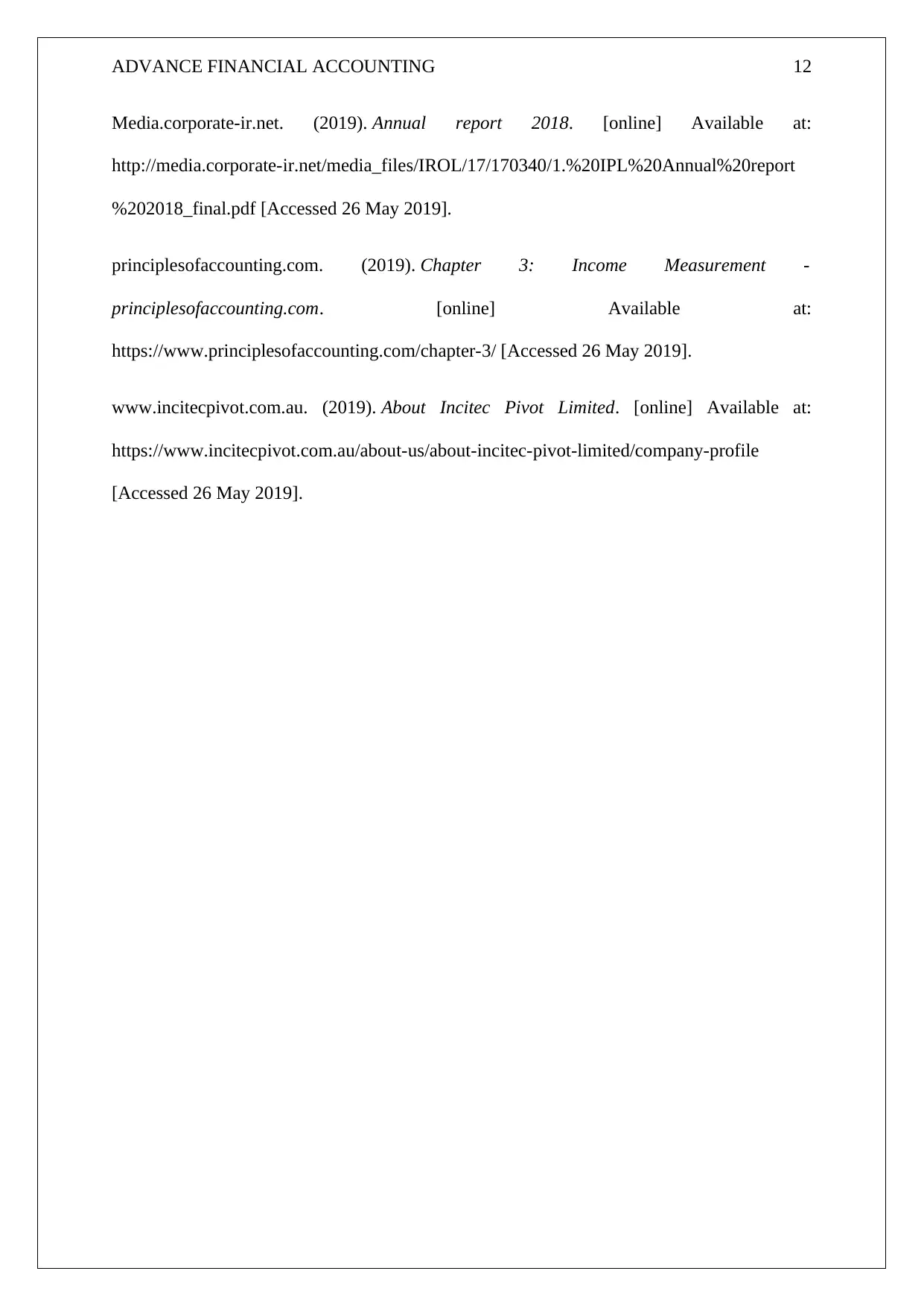
ADVANCE FINANCIAL ACCOUNTING 12
Media.corporate-ir.net. (2019). Annual report 2018. [online] Available at:
http://media.corporate-ir.net/media_files/IROL/17/170340/1.%20IPL%20Annual%20report
%202018_final.pdf [Accessed 26 May 2019].
principlesofaccounting.com. (2019). Chapter 3: Income Measurement -
principlesofaccounting.com. [online] Available at:
https://www.principlesofaccounting.com/chapter-3/ [Accessed 26 May 2019].
www.incitecpivot.com.au. (2019). About Incitec Pivot Limited. [online] Available at:
https://www.incitecpivot.com.au/about-us/about-incitec-pivot-limited/company-profile
[Accessed 26 May 2019].
Media.corporate-ir.net. (2019). Annual report 2018. [online] Available at:
http://media.corporate-ir.net/media_files/IROL/17/170340/1.%20IPL%20Annual%20report
%202018_final.pdf [Accessed 26 May 2019].
principlesofaccounting.com. (2019). Chapter 3: Income Measurement -
principlesofaccounting.com. [online] Available at:
https://www.principlesofaccounting.com/chapter-3/ [Accessed 26 May 2019].
www.incitecpivot.com.au. (2019). About Incitec Pivot Limited. [online] Available at:
https://www.incitecpivot.com.au/about-us/about-incitec-pivot-limited/company-profile
[Accessed 26 May 2019].
⊘ This is a preview!⊘
Do you want full access?
Subscribe today to unlock all pages.

Trusted by 1+ million students worldwide
1 out of 12
Related Documents
Your All-in-One AI-Powered Toolkit for Academic Success.
+13062052269
info@desklib.com
Available 24*7 on WhatsApp / Email
![[object Object]](/_next/static/media/star-bottom.7253800d.svg)
Unlock your academic potential
Copyright © 2020–2025 A2Z Services. All Rights Reserved. Developed and managed by ZUCOL.




